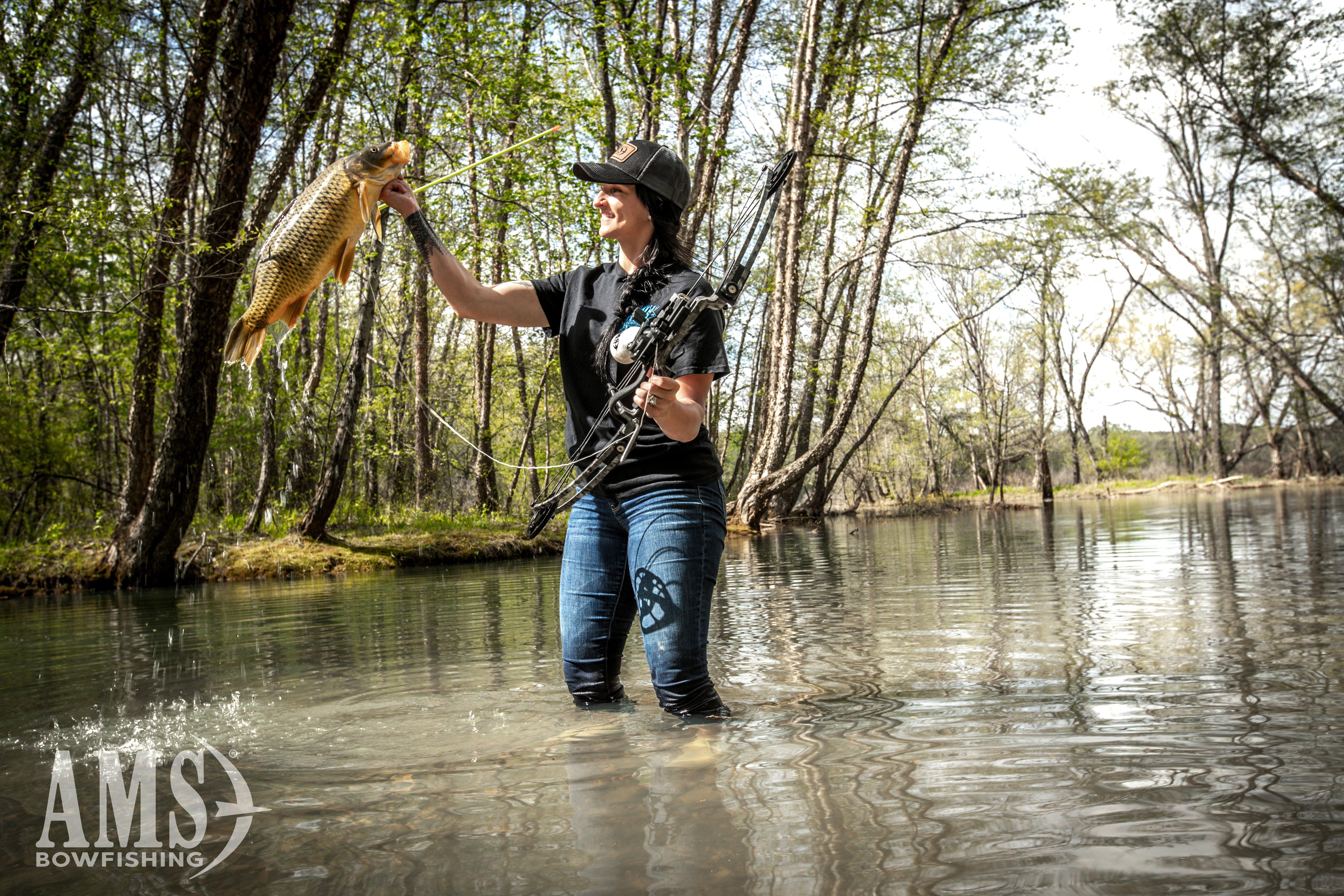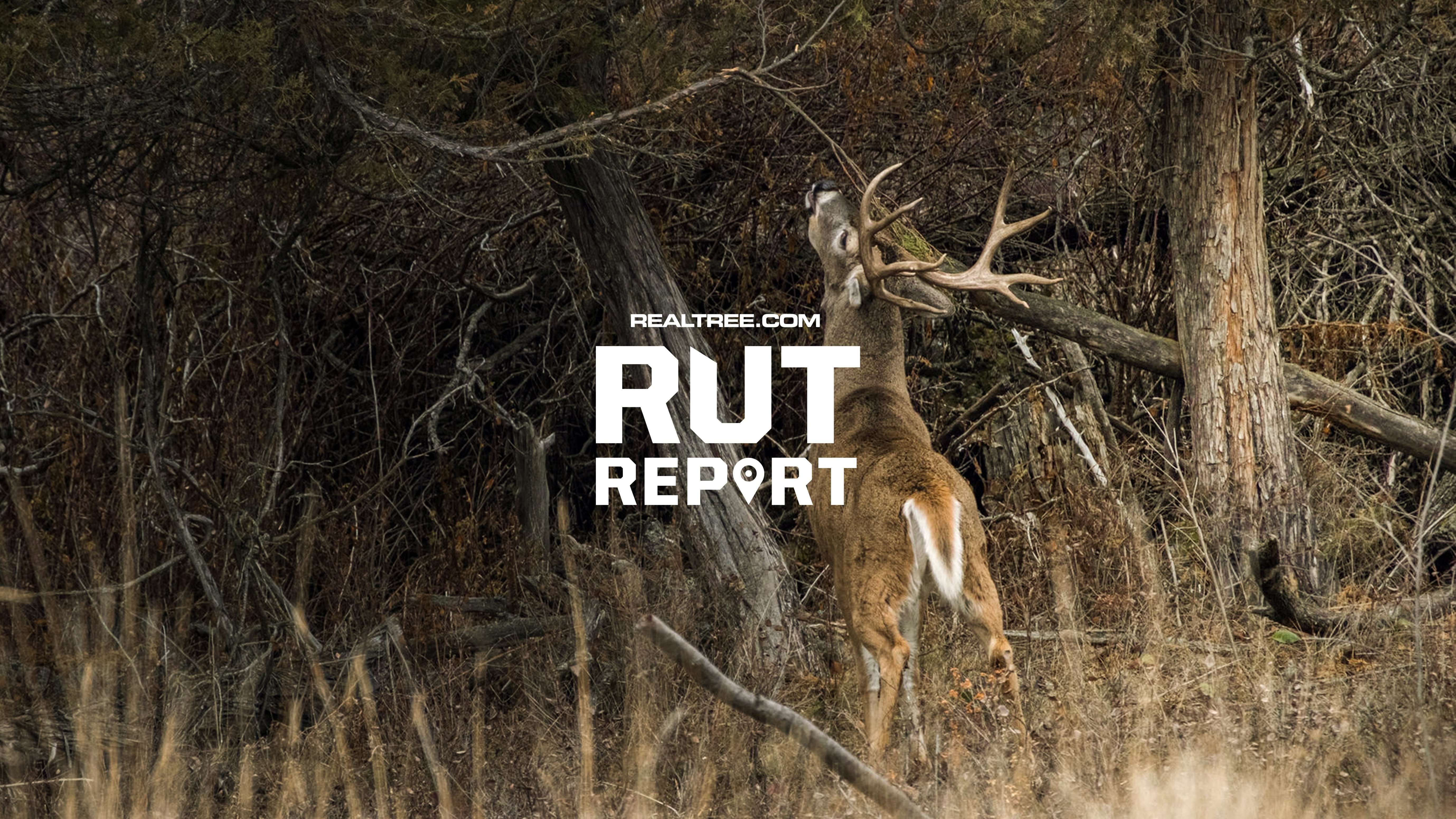Stalking the shallows during the day with polarized sunglasses is a great way to shoot fish, and affordable too

You don’t need a fancy boat to be successful at bowfishing. Image by AMS Bowfishing
Not much can top coming to full draw on a 30-pound carp illuminated underwater — and then doing it a few dozen more times in one night. The excitement of arrows constantly flying while being surrounded by friends beneath the stars is the ultimate summertime rush.
But even if you don’t have a buddy with a boat or the budget to invest in your own, you can still enjoy bowfishing success by shooting from the bank or wading in the shallows.
Boat or No Boat
Bowfishing at night on a boat is my favorite way to enjoy the sport, but because I have only occasional access to a watercraft, I’ve learned to improvise. Most times when I’m itching to arrow some carp, I take to a local creek on foot during daylight hours instead. Beyond the obvious flexibility this type of bowfishing offers, it’s also hassle-free. No loading up a boat or trying to locate dock access — just grab your bow and go.
With a boom in bowfishing popularity in recent years, popular spots are getting bombarded at night. Boats are crowding rivers, and sportsmen are now stuck sharing their honey holes. In fact, the uptick in nighttime bowfishing has even prompted states such as Pennsylvania to enforce stricter regulations on bowfishing lights and generator noise levels, costing bowfishermen thousands in upgrades and even access to their favorite spots. Besides that, bugs often swarm the lights required for bowfishing at night, leaving you with frequent mouthfuls of insects.
Shooting during the day, then, has its perks. The bugs aren’t as bad, and the carp waters are usually significantly less crowded. In fact, I’ve never encountered competition while walking along the shoreline with my bow in hand. And while bowfishing lights can provide a great glimpse into the darkness a few yards ahead, they can’t provide the same level of visibility across a body of water that bright sunshine can. Plus, while on foot, you can bowfish narrow waters and shallow shorelines that aren’t accessible by boat. It makes for a fun challenge akin to spotting and stalking in the hunting offseason.
Bowfishing Gear
While buying a boat equipped with a bowfishing platform and lights could easily cost you tens of thousands of dollars, bowfishing on foot is a relatively affordable hobby with minimal gear required. You need a reliable rig with a quality reel, a couple arrows tipped with bowfishing points, and a pair of polarized sunglasses that reduce glare to help you spot targets. That’s about it. Whether you rework a retired hunting bow or purchase a brand-new bowfishing setup, you can be water-ready for just a few hundred bucks.

Wading allows access to areas that boats can’t reach. Image by AMS Bowfishing
Locating Fish
The best time and place to bowfish can depend on whether you’re after carp, catfish, gar, suckers, snakeheads, or other arrowable species. Generally, the spawning period of your target fish is the best time of year for daylight bowfishing. Once water reaches the mid 60s, you’ll usually find carp and other fish in the shallows. If possible, plan to shoot on calm, cloudless days with normal to high barometric pressure.
Mornings just after sunrise, when harsh sunlight isn’t directly overhead, are best, followed by the final hour or two before sunset. But during the peak carp spawn in late spring, you can have luck at just about any time of day.
Do some research and scouting to locate waters with large fish populations for a target-rich environment. Although you might see carp in some muddier areas, water that’s calm and relatively clear is ideal. Gar, on the other hand, are often concentrated in moving water.
Shallow water (3 feet or less) will make spotting fish on the bottom easier and allow for better aiming and arrow penetration. Scope out shallow grass flats as well as areas with downed trees or lots of rocks where fish could seek refuge.
If you’re struggling to find a great daytime bowfishing spot, state agencies are often able to provide local recommendations.
Bowfishing by Foot Tactics
Regardless of region, species, or time, stealth is the name of the game when bowfishing on foot. You’ll want to tread lightly, stay quiet, and avoid casting a shadow over the water as you slowly move in search of your next target. Look for ripples in calm water and use your polarized sunglasses to get a better look at what’s hanging out below the surface.
The most common tactic is to hug the banks of bodies of water, being mindful of where the sun is dropping your shadow. Do you spot and stalk big game in the fall? Use those same skills as you gingerly cover ground and eye the shallows for signs of fins.
Alternatively, you can slip into waders — or not — and cautiously move through the water with bow in hand. Sometimes wading can help you reach otherwise inaccessible areas or get a better angle at fish, but it requires an even greater degree of stealth to prevent spooking them. Shuffle through the water as slowly as possible and avoid splashing or causing any ripples.
Where allowed, some bowfishermen try chumming with bait such as canned sweet corn, hemp seeds, dog food, and pellets to attract fish and increase shot opportunities. Although this strategy can be effective, it can also attract non-target species and is illegal or restricted in many states.
Whether you sneak up on a carp from the bank, wade your way across the water to one, or draw a few in with chum, you’ll want to stay on your toes and be ready to shoot quickly. Confirm your target first; this can be tough when bright sun is reflecting off the water, but never shoot at a fish unless you’re sure of what it is.
If you’re sneaking a few feet from the water to avoid casting shadows, draw your bow as you’re shifting into shooting position and let fly as fast as possible.
Missed? That’s OK. The fish could return in a few minutes after the water settles again, or you can move onto a new target.

The author shows off a good-sized carp, arrowed from the bank. Image courtesy of Emily Kantner
Refraction & Aiming
Bowfishing — whether from a boat or on foot — comes with a learning curve. If you aim directly at the fish like you would an animal on land, you’ll shoot over it by several inches. As light moves from air to water, it refracts and makes fish appear as if they’re sitting higher in the water than they really are.
So, while you don’t have time to overthink your shot without alerting fish, you do need to account for refraction and train yourself to quickly adjust your aiming on the fly.
Some experts recommend aiming 10 inches directly below where you want to hit the fish, and others suggest holding 6 inches low for every foot of depth. But the most accurate method is to follow the 10-4 rule: when a fish is 10 feet away and 1 foot below the surface, aim 4 inches low. If either the distance or depth doubles, double the 4-inch hold to 8 inches. So, if a buffalo is sitting 10 feet from you, 2 feet down, aim 8 inches below it.
There’s still some level of approximation, no matter which method you use. It simply takes time to develop the skill to draw, aim, and shoot instinctively.
Since you can’t truly simulate the effects of refraction on dry land, the best practice is shooting over the top of dozens of fish until you finally learn that when you think you’re aiming too low, you should probably aim a little lower. Even missing is a blast and will ultimately make you a better all-around outdoorsman.
Bowfishing Regulations
Before you head out bowfishing by foot or boat, be sure to check local regulations. Bowfishing regulations typically aren’t too stringent overall, but they can vary from state to state. Some require bowfishermen to maintain a minimum distance from certain structures and stick to certain waters. Bowfishing species, legal equipment, license requirements, and seasons will also depend on where you’re shooting.
(Don’t Miss: 3 BEST LURES FOR CATCHING A 10-POUND BASS)












